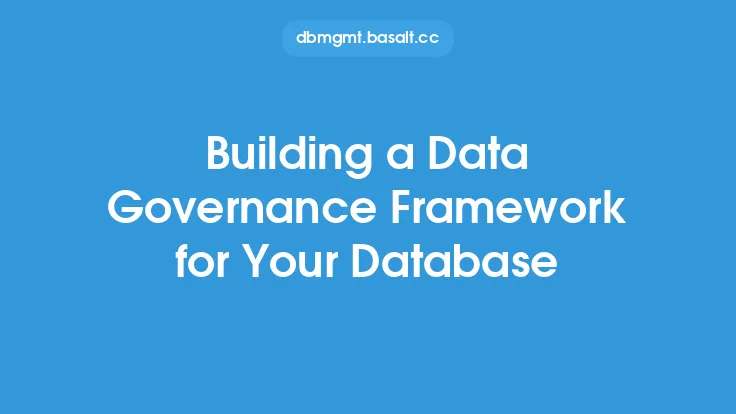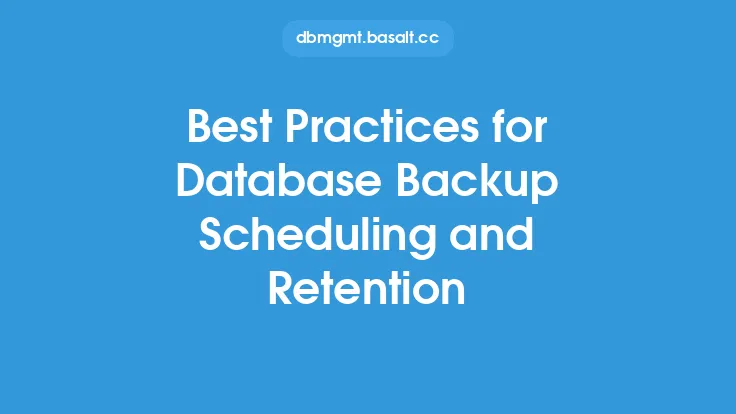Developing a comprehensive data retention policy is a crucial aspect of database design, as it ensures that an organization's data is handled, stored, and disposed of in a manner that is compliant with regulatory requirements, supports business operations, and minimizes risk. A well-crafted data retention policy provides a clear framework for managing the lifecycle of data, from creation to deletion, and helps to maintain the integrity, availability, and confidentiality of an organization's data assets.
Understanding Data Retention
Data retention refers to the period of time during which an organization retains its data, including electronic records, documents, and other types of digital information. The retention period is typically determined by regulatory requirements, business needs, and industry standards. A data retention policy outlines the rules and procedures for managing data throughout its lifecycle, including data creation, storage, retrieval, and disposal.
Key Considerations for Developing a Data Retention Policy
When developing a data retention policy, several key considerations must be taken into account. These include:
- Regulatory compliance: Organizations must comply with relevant laws, regulations, and industry standards that govern data retention, such as the General Data Protection Regulation (GDPR), the Health Insurance Portability and Accountability Act (HIPAA), and the Payment Card Industry Data Security Standard (PCI DSS).
- Business requirements: The data retention policy must support business operations and decision-making, while also ensuring that data is retained for a sufficient period to meet business needs.
- Data classification: A data classification system must be established to categorize data based on its sensitivity, importance, and retention requirements.
- Data storage and management: The policy must outline procedures for storing, managing, and retrieving data, including data backup, archiving, and recovery procedures.
- Data disposal: The policy must specify procedures for disposing of data that is no longer required, including secure deletion and destruction methods.
Components of a Data Retention Policy
A comprehensive data retention policy should include the following components:
- Data retention schedule: A schedule that outlines the retention period for each type of data, including the length of time data is retained and the criteria for disposing of data.
- Data classification system: A system for categorizing data based on its sensitivity, importance, and retention requirements.
- Data storage and management procedures: Procedures for storing, managing, and retrieving data, including data backup, archiving, and recovery procedures.
- Data disposal procedures: Procedures for disposing of data that is no longer required, including secure deletion and destruction methods.
- Compliance and regulatory requirements: A statement outlining the organization's compliance with relevant laws, regulations, and industry standards.
- Roles and responsibilities: A statement outlining the roles and responsibilities of personnel involved in data retention and management.
Implementing a Data Retention Policy
Implementing a data retention policy requires a structured approach that involves several key steps. These include:
- Conducting a data inventory: Identifying and categorizing all data assets, including electronic records, documents, and other types of digital information.
- Developing a data retention schedule: Creating a schedule that outlines the retention period for each type of data.
- Establishing data storage and management procedures: Developing procedures for storing, managing, and retrieving data.
- Implementing data disposal procedures: Developing procedures for disposing of data that is no longer required.
- Training personnel: Providing training to personnel involved in data retention and management on the data retention policy and procedures.
- Monitoring and reviewing the policy: Regularly monitoring and reviewing the data retention policy to ensure it remains effective and compliant with regulatory requirements.
Technical Considerations for Data Retention
From a technical perspective, implementing a data retention policy requires consideration of several key factors, including:
- Data storage systems: The type and configuration of data storage systems, including databases, file systems, and cloud storage.
- Data backup and archiving: The procedures and systems used for backing up and archiving data.
- Data retrieval and recovery: The procedures and systems used for retrieving and recovering data.
- Data encryption and access controls: The use of encryption and access controls to protect data from unauthorized access.
- Data deletion and destruction: The procedures and systems used for securely deleting and destroying data.
Best Practices for Data Retention
Several best practices can be applied to ensure effective data retention, including:
- Regularly reviewing and updating the data retention policy: Ensuring the policy remains effective and compliant with regulatory requirements.
- Implementing automated data management processes: Using automated processes to manage data, including data backup, archiving, and disposal.
- Providing training to personnel: Ensuring personnel involved in data retention and management are aware of the data retention policy and procedures.
- Monitoring data storage and management systems: Regularly monitoring data storage and management systems to ensure they are functioning correctly and securely.
- Conducting regular data audits: Conducting regular audits to ensure data is being retained and managed in accordance with the data retention policy.





